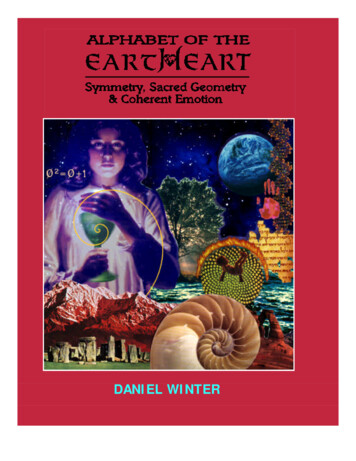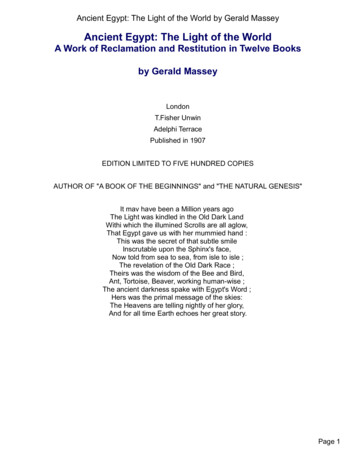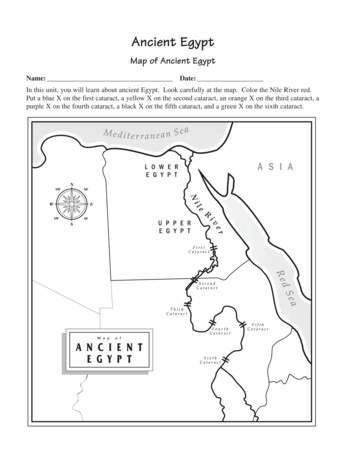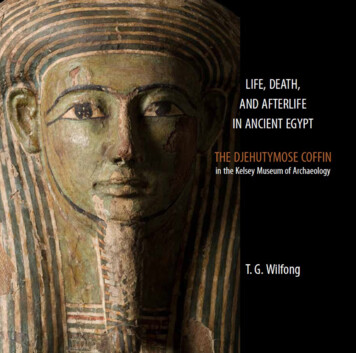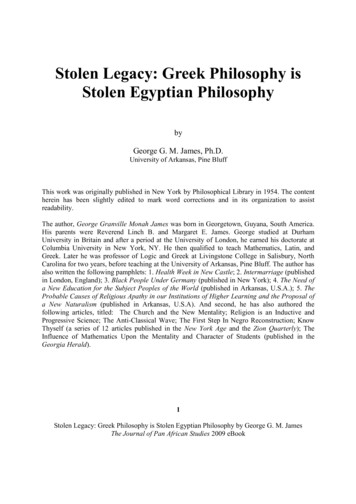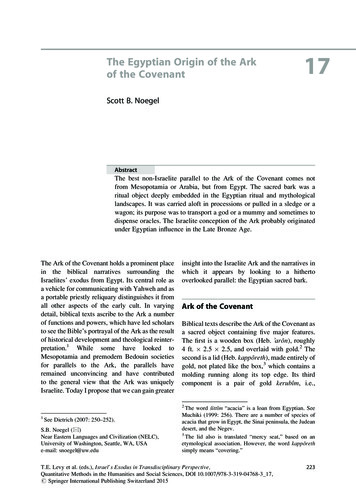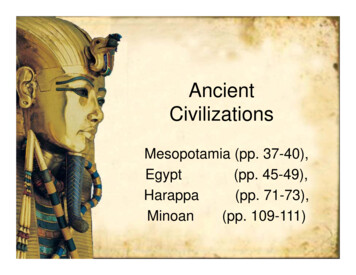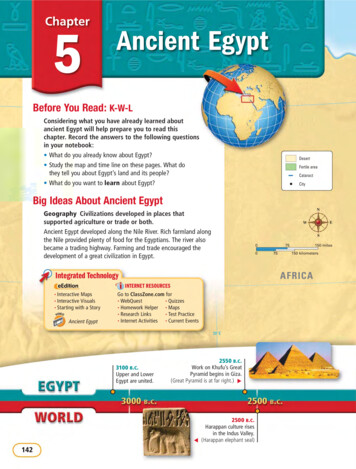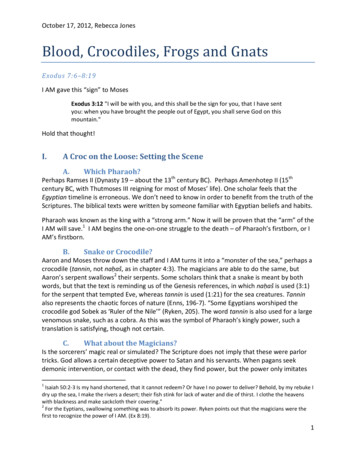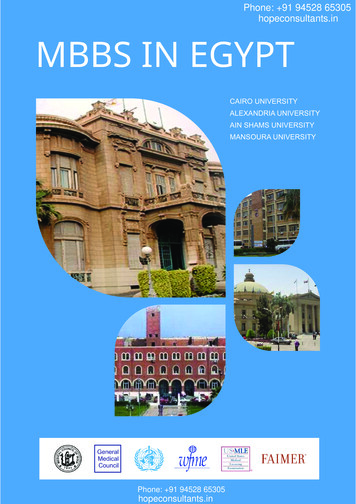
Transcription
Egyptian MysticsSeekers of The WayExpanded Second EditionMoustafa GadallaMaa Kheru (True of Voice)Tehuti Research FoundationInternational Head Office: Greensboro, NC, U.S.A.
Egyptian MysticsSeekers of The WayExpanded 2nd Editionby Moustafa GadallaPublished by:Tehuti Research FoundationP.O. Box 39491Greensboro, NC 27438, U.S.A.All rights reserved. No part of this book may be reproduced ortransmitted in any form or by any means, electronic or mechanical,including photocopying, recorded or by any information storage andretrieval system without written permission from the author, exceptfor the inclusion of brief quotations in a review.Copyright 2003 and 2016 by Moustafa Gadalla, All rights reserved.First edition published in paperback in 2003. ISBN: 1-931446-05-9(pbk) ; and ISBN: 1-931446-15-6 (E-book)This book being the Second Edition is a revised and expanded editionof the First Edition of Egyptian Mystics; Seekers of The Way, byMoustafa Gadalla.Publisher’s Cataloging-in-PublicationGadalla, Moustafa, 1944Egyptian mystics: seekers of the way / Moustafa Gadalla.—2nd ed., rev.p. cm.Includes bibliographical references.Preassigned LCCN: 2016930018ISBN-13(pdf): 978-1-931446-53-2ISBN-13(e-book): 978-1-931446-54-9ISBN-13(pbk.): 978-1-931446-55-61. Sufism—Origin. 2. Sufism—Egypt. 3. Egypt—Religion—Influence. 4.Egypt—Civilization. 5. Occultism—Egypt. I. TitleBP189.2.G33 2016 297.4
Published 2016
CONTENTSAbout the AuthorxiPreface [2nd Edition]xiiiPreface [1st Edition]xviiStandards and TerminologyMap of Egypt and SurroundingCountriesxixxxiiiPART I : THE HIDDEN TREASUREChapter 1 : Egyptian Mysticism andIslamized Sufism31.1 Dogmatic and Mystical Routes1.2 Egyptians: The Most Religious1.3 The Source of Sufism345Chapter 2 : The Treasure Within132.1 The Image of God2.2 Organs of Perception2.3 The Power of Love131415
PART II : TRANSFORMATION FROM DUST TOGOLDChapter 3 : The Alchemist Way193.1 Atum/Adam: The Alchemist Goal3.2 Progressive Sowing and Reaping3.3 Your Guiding Angels3.4 Anubis—Archetypal Alchemical Guide3.5 The Thrice Thoth1921222425Chapter 4 : The Purification Process294.1 Pure Gold (Purifying the Heart and Tongue)4.2 The Healthy Body4.3 Getting Out of the Box4.4 Battling the Enemies (Impurities) Within4.5 The Ego—Personal Enemy #14.6 The Do’s and Don’ts4.7 The Pauper is a Prince29313233353740Chapter 5 : Basic Practices435.1 The Power of Concentration5.2 The Animated Breathing Techniques5.3 Playing Music5.4 Recitations of Names, Rosaries, etc.5.5 Sports and Rhythmic Movements5.6 Mind Games5.7 Contemplation and Mediation (Astral Travel)5.8 Group Astral Travel Practices5.9 Enduring Love (Mind Over Matter)434445464749495051
Chapter 6 : The Way to Revelations536.1 No Chosen People6.2 Re—The Unity of Multiplicity6.3 Dualism—The Essence of Creation6.4 Reconciliation of Dualities (Tying/Untyingthe Knot)6.5 Knowledge by Spiritual Revelation (Zikr)6.6 Unification and Deification6.7 Pir: The Power House53545557Chapter 7 : The Heavenly Helpers657.1 The Eternal Perfect Servants (The Walis)7.2 Staying Alive7.3 The Blessed Shrines (The Ka Houses)656667606263PART III : THE PUBLIC VISITATION FAIRSChapter 8 : The Cyclical RenewalFestivals758.1 The Need for Renewal8.2 The History of Mouleds in Egypt8.3 The Festival Regulators (Isis and Osiris)8.4 Setting the Dates (Rejuvenation Cycles)75777980
Chapter 9 : Samples of Ancient-PresentFestivals879.1 Familiar Festivals9.2 The Egyptian Calendrical New Year’s Day9.3 The Wag Festival9.4 The Conception (Planting) Mouled9.5 The Last Supper (Darkness Overtakes Light)9.6 The Advent of Osiris9.7 The King’s New Year’s Day (January 1)9.8 Epiphany (January 6)9.9 Lent9.10 Easter9.11 Ascension Day9.12 The First Teardrop9.13 The Egyptian Pentecost9.14 Transfiguration of Horus9.15 Our Lady Meriam (Assumption of Our LadyDay)9.16 Isis’ (Mary’s) Birthday878888899092949595969798100101103Chapter 10 : The Egyptian Spirited Fairs(Mouleds)10510.1 Family Reunion10.2 The Mouleds’ Overall Plan of Activities105107Chapter 11 : Egyptian Themes of SaintNick's Traditional Festivities131104PART IV : COME ONE COME ALLChapter 12 : Fellowship Formations14312.1 The Universality of Egyptian Mysticism12.2 The Countless Ways12.3 The Principles of a Fellowship143144145Chapter 13 : Isis —The ModelPhilosopher153
Appendix A: Miscellaneous Sufi Termsand Their Ancient Egyptian Roots159A.1 The Gazelle’s SymbolismA.2 Music of the StonesA.3 The Word of GodA.4 The Names of GodA.5 The Written Word, Sacred Geometry, etc.A.6 The Heart and the TongueA.7 The Canopus Mystical DoctrineA.8 The Fountain of Youth159160161161162163165166Appendix B: Sleeping With The Enemy(Surviving Islam)169Appendix C: Zikr—The Ecstatic Practice173Appendix D: Reaching the Hearts andMinds (Effective Communication)185Appendix E: The Egyptian vs. The LatinCalendar189Glossary193Selected Bibliography201Sources and Notes207TRF Publications215
ABOUT THE AUTHORMoustafa Gadalla is an Egyptian-American independentEgyptologist who was born in Cairo, Egypt in 1944. Heholds a Bachelor of Science degree in civil engineeringfrom Cairo University.Gadalla is the author of twenty two published internationally acclaimed books about the various aspects of theAncient Egyptian history and civilization and its influences worldwide.He is the Founder and Chairman of the Tehuti ResearchFoundation (https://ww.egypt-tehuti.org)—an international, U.S.-based, non-profit organization dedicated toAncient Egyptian studies. He is also the Founder andHead of the online Egyptian Mystical rg).From his early childhood, Gadalla pursued his AncientEgyptian roots with passion, through continuous studyand research. Since 1990, he has dedicated and concentrated all his time to researching and writing.EGYPTIAN MYSTICS xi
PREFACE [2ND EDITION]This book being the Second Edition is a revised andexpanded edition of the First Edition of Egyptian Mystics:Seekers of The Way, published in 2003.This book explains how Ancient Egypt is the origin ofalchemy and present-day Sufism, and how the mysticsof Egypt camouflage their practices with a thin layer ofIslam. The book also explains the progression of the mystical Way towards enlightenment, providing a coherentexplanation of its fundamentals and practices. It showsthe correspondence between the Ancient Egyptian calendar of events and the cosmic cycles of the universe.It is the aim of this book to provide such an exposition;one which, while based on sound scholarship, will presentthe issues in language comprehensible to non-specialistreaders. Technical terms have been kept to a minimum.These are explained, as non-technically as possible, in theglossary. This Expanded Version of the book is dividedinto four parts containing a total of 13 chapters and fiveappendices.Part I: The Hidden treasure consists of two chapters:EGYPTIAN MYSTICS xiii
Chapter 1: Egyptian Mysticism and Islamized Sufismwill cover the differences between dogmatic and mysticalroutes and how ancient Egypt is the source of Sufism andalchemy.Chapter 2: The Treasure Within will cover the limitations of humans organ of perceptions and how to findrealities with such limitations.Part II: Transformation From Dust To Gold consists offive chapters—3 through 7:Chapter 3: The Alchemist Way will cover the source ofalchemy as being from Ancient Egypt; the progressionalong the alchemist way; and the role of a guide in theprocess.Chapter 4: The Purification Process will cover bothouter and inner purifications through the process of living in the world.Chapter 5: Basic Practices will cover general practices bythe Egyptian mystics to increase their awareness of thereal world.Chapter 6: The Way to Revelations will cover the methods by which a mystical aspirant can find knowledgethrough revelations.Chapter 7: The Heavenly Helpers will cover the role andduty of those who attained supernatural powers, to helpothers on Earth.xiv MOUSTAFA GADALLA
Part III: The Public Visitation Fairs has four chapters—Chapters 8 through 11:Chapter 8: The Cyclical Renewal Festivals will coverthe importance of holding and participating in annualfestivals.Chapter 9: Samples of Ancient-Present Festivals willcover about a dozen annual ancient Egyptian festivalsand how many of them are very familiar and are beingobserved throughout the Western world.Chapter 10: The Egyptian Spirited Fairs (Mouleds) willcover the main elements of a typical festivalChapter 11: Egyptian Themes of Saint’s Nick Traditional Festivities will offer a comparison between thecommonly known Saint Nick’s Christmas traditions andthe typical Ancient Egyptian festival of a folk-saint.Part IV: Come One Come All has two chapters—12through 13.Chapter 12: Fellowship Formations covers the generalstructure and practices to form/participate in a mysticalfellowship.Chapter 13: Isis —The Model Philosopher covers theprinciples and practices of Sufism as found in the AncientEgyptian allegory of Isis and Osiris.EGYPTIAN MYSTICS xv
The contents of the five appendices are self evident fromeach’s title, as follows:Appendix A: Miscellaneous Sufi Terms and TheirAncient Egyptian RootsAppendix B: Sleeping With the Enemy (SurvivingIslam)Appendix C: Zikr—The Ecstatic PracticeAppendix D: Reaching the Hearts and Minds (EffectiveCommunication)Appendix E: The Egyptian vs. the Latin CalendarMoustafa Gadallaxvi MOUSTAFA GADALLA
PREFACE [1ST EDITION]Herodotus stated, in 500 BCE: “Of all the nations in theworld, the Egyptians are the happiest, healthiest and mostreligious.”Religiousness for the Ancient Egyptians was total cosmicconsciousness. The Egyptian concept is now commonlyknown in the East as Sufism and in the West as alchemy.This book explains how Ancient Egypt is the root of present-day Sufism/alchemy, and how the mystics of Egyptcamouflaged their practices under a thin layer of Islam.This book will also show how other peoples tried toadopt the Egyptian model, but fell short and ended upwith partial and incomplete applications. Egyptian mystical teachings and practices are markedly different fromthose practiced by Sufis in other countries, as is shownthroughout this book.The Egyptian model of mysticism is not about the outerworld or a community of believers, dogma, scriptures,rules, or rituals. It does not involve simply believing thatGod is this, or God is that or that. It is not just askingone to “believe” and one is automatically in God’s graces.The Egyptian model of mysticism consists of ideas andEGYPTIAN MYSTICS xvii
practices that provide the tools for any spiritual seekerto progress along each’s alchemical Path towards “unionwith the Divine”.This spiritual Path towards union requires one to engagein the hard and sometimes painful (but joyful) commitment to inner and outer purification. The spiritual seekermust gain knowledge of reality/truth, do well in everything, and apply what he/she has learned in the world.It is a philosophy of life; a way of individual behavior inorder to achieve the highest morality and internal happiness and peace.The general perception of mysticism is that it is possibleto achieve communion with God by attaining knowledgeof spiritual truth through intuition acquired by fixedmeditation. The Egyptian model for gaining knowledge isbased on the utilization of both intellect and intuition.In the Egyptian model, there are no “chosen people” whoare picked by God or a religious authority. One must seekthe Divine through a hard labor of love. Those who succeed in achieving union with the Divine are chosen andvenerated by the masses.This book intends to clarify these facts and to shed lighton the Egyptian mystical model (Sufism)—yet not toomuch light; because that could endanger the traditionsand their practitioners under the present ever-threatening dark cloud of Islam.Moustafa GadallaTo-beh 1, 13,001 (Ancient Egyptian Calendar)January 9, 2003 CExviii MOUSTAFA GADALLA
STANDARDS AND TERMINOLOGY1. The Ancient Egyptian word neter and its feminineform, netert, have been wrongly and possibly intentionally translated to ‘god’ and ‘goddess,’ by almost all academicians. Neteru (plural of neter/netert) are the divineprinciples and functions of the One Supreme God.2. You may find variations in writing the same AncientEgyptian term, such as Amen/Amon/Amun or Pir/Per.This is because the vowels you see in translated Egyptiantexts are only approximations of sounds which are usedby Western Egyptologists to help them pronounce theAncient Egyptian terms/words.3. We will be using the most commonly recognized wordsfor the English-speaking people that identify a neter/netert [god, goddess] or a pharaoh or a city; followed byother ‘variations’ of such a word/term.It should be noted that the real names of the deities (gods,goddesses) were kept secret so as to guard the cosmicpower of the deity. The Neteru were referred to by epithets that describe particular qualities, attributes and/oraspect(s) of their roles. Such applies to all common termssuch as Isis, Osiris, Amun, Re, Horus, etc.EGYPTIAN MYSTICS xix
4. When using the Latin calendar, we will use the following terms:BCE – Before Common Era. Also noted in other references as BC.CE – Common Era. Also noted in other references asAD.5. The term Baladi will be used throughout this book todenote the present silent majority of Egyptians thatadhere to the Ancient Egyptian traditions, with a thinexterior layer of Islam. The Christian population of Egyptis an ethnic minority that came as refugees from Judaeaand Syria to the Ptolemaic/Roman-ruled Alexandria.Now, 2,000 years later, they are easily distinguishable inlooks and mannerisms from the majority of native Egyptians. [See Ancient Egyptian Culture Revealed, by MoustafaGadalla, for detailed information.]6. There were/are no Ancient Egyptian writings/textsthat were categorized by the Egyptians themselves as“religious”, “funerary”, “sacred”, etc. Western academiagave the Ancient Egyptian texts arbitrary names, such asthe “Book of This” and the “Book of That”, “divisions”,“utterances”, “spells”, etc. Western academia even decidedthat a certain “Book” had a “Theban version” or “thisor that time period version”. After believing their owninventive creation, academia then accused the AncientEgyptians of making mistakes and missing portions oftheir writings(?!!).For ease of reference, we will mention the common butarbitrary Western academic categorization of Ancientxx MOUSTAFA GADALLA
Egyptian texts, even though the Ancient Egyptians themselves never did.EGYPTIAN MYSTICS xxi
MAP OF EGYPT AND SURROUNDINGCOUNTRIESEGYPTIAN MYSTICS xxiii
The Egyptian model of mysticism is not about the outer world or a community of believers, dogma, scriptures, rules, or rituals. It does not involve simply believing that God is this, or God is that or that. It is not just asking one to "believe" and one is automatically in God's graces. The Egyptian model of mysticism consists of ideas and
